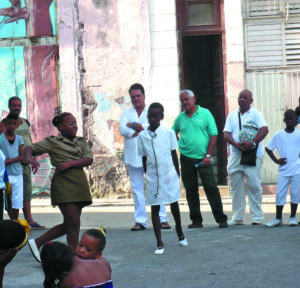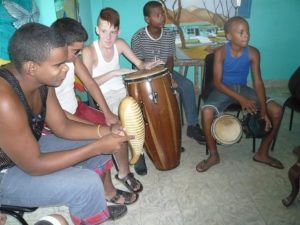
By Leni Reeves

We were a small determined group—the 2014 Pastors for Peace Caravan to Cuba. Our oldest was Women’s International League for Peace and Freedom (WILPF) member Judy Geer from Santa Cruz, our youngest was one of the three grandchildren she brought with her. They and we all did more than our share of work; there was the same amount of work as always although fewer people to do it. Our routes through Canada and the United States had converged on McAllen, Texas, as usual. But McAllen had changed or perhaps we learned to see it differently.
The so-called immigration crisis, really a refugee crisis, and ongoing community problems had evoked a powerful community response. La Union del Pueblo Entero (LUPE) is a south Texas organization based on United Farm Workers family organizing. They welcomed us and fed our minds and bodies.
LUPE members took us to see the welcoming center: When refugee families have relatives in the United States willing to sponsor them financially, they are released on their “own recognizance.” They leave official custody after 3–10 days—dehydrated, starved, dirty, exhausted and without the few belongings they might have had. At the welcoming centers, new arrivals get a welcome, water, food, a shower, clothing, medical attention, legal aid, assistance with travel arrangements and a place to rest overnight.
LUPE also did a workshop for us about refugee and immigration issues. The level of information and analysis was high; I thought I knew a lot about this issue but I learned more. This included a workshop by the South Texas Human Rights Center, which has a mission to end death and suffering among migrant border crossers. One of their projects is to place water stations. Another is to make sure that all dead people found along the Texas border are DNA tested, so that families can find out the fate of their own.
As we crossed the border heading south, Sister Norma was negotiating with U.S. officials for access to the detained unaccompanied children. My ideas about Texas were completely changed on this trip.
We drove through the war zone of northern Mexico, a country wounded almost to death by NAFTA and the War on Drugs. Poor boys with sad dark faces, wearing heavy body armor in the hot sun and carrying automatic weapons accompanied us in armored vehicles with mounted artillery. The Mexican government doesn’t want a Caravan hijacked.
From Tampico, we flew to Havana. Suddenly, the streets were safe, the people unafraid. There is a sense of relief I always feel when I arrive in Cuba, especially when, in the United States, there has been a recent mass shooting, or a recent police shooting of an unarmed person, almost always Black or Brown.

We didn’t have time to go everywhere and see everything in Cuba or even in Havana, but our schedule was so crowded that at times it seemed we were trying to. Lots of music; conferences on race, religion, gender, the U.S. blockade of Cuba and the Cuban 5; the 26th of July commemoration in Artemisa after a CDR party where we danced until late the night before; the beach; biotechnological research; weeding the sugarcane fields; the Latin American School of Medicine, where there are currently 114 U.S. students learning to be doctors for poor people in the United States, as well as 112 U.S. grads who are already doing this; community and religious projects; children’s theater; urban organic farms/gardens; and much more.
Here’s a little information from two of the conferences.
Cuban 5
Sept. 12 is the 16th anniversary of the arrest of the Cuban 5. These are five Cubans who infiltrated the Miami anti–Cuban Revolution organizations to investigate what terrorist activities were being planned. (The bombing of a civilian airliner with the death of all those on board, including 24 children, and tourist hotel arson and bombings are two examples of their past terrorist actions.) The undercover investigators were arrested as spies and tried in Miami, convicted and sentenced unjustly. Two have completed their long sentences and been released. Unacceptably, three remain in prison, one with a life term. There are no further legal avenues to explore, and the only solution is a political one. The movement to free the Cuban 5 continues to gain strength; we will need it.
Blockade
In addition to the blockade/“embargo” we all know about—the United States refusing to buy from or sell to Cuba, and pressuring other countries to do the same, even when it deals with medicines or products such as pacemakers—there is a new emphasis and intensification. This is to try to cut off all credit and financial transactions of banks throughout the world, pressuring and threatening them so that no business can be done in Cuba.
The fines and sanctions against BNP Paribas demonstrate the long arm of the U.S. government, with respect to even a large foreign bank. The United States recently caused the Bank of Ireland to cease all transactions with Cuba. This is a newly intensified form of the blockade under Obama who just renewed the blockade for another year declaring it “in the interests of the United States.” The most recent UN vote on this issue was 188 countries against the blockade and two in favor—the United States and its client state Israel.
The Cubans were grateful for our presence, our solidarity and our willingness to learn about the Cuban reality the struggles of life. They appreciated learning from us about our struggles as U.S. activists.
Action, Information and More Action
- Contact President Barack Obama, Sen. Dianne Feinstein and Sen. Barbara Boxer and demand an end to the blockade/embargo.
- LUPE La Unión del Pueblo Entero: http://lupenet.org/
- South Texas Human Rights Center: southtexashumanrights.org
- IFCO Pastors for Peace: www.ifconews.org/
- International Committee for the Freedom of the Cuban 5: www.thecuban5.org/
*****
Leni Reeves is a physician, activist, guitarist and volunteer firefighter. Read about some of her Cuba experiences at www.usmdincuba.blogspot.com, and contact her at lenivreeves@gmail.com.
